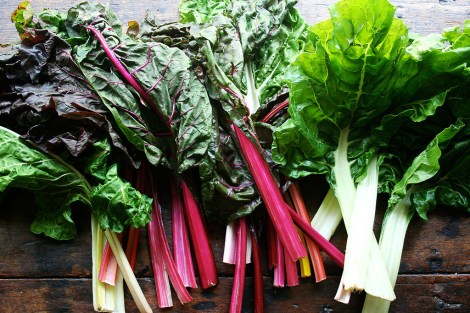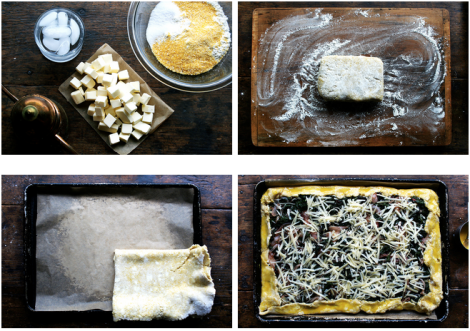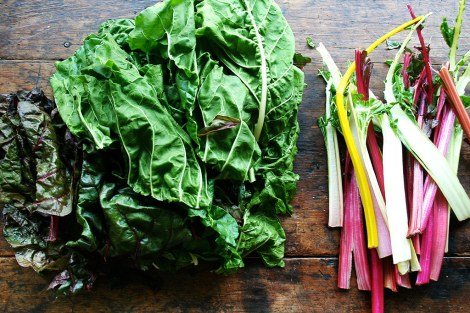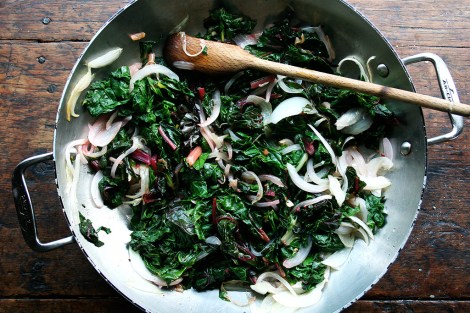It’s the season of overflowing market bags, heavy CSA boxes, and gardens run amok. Alexandra Stafford of Alexandra Cooks is showing us how to store, prep, and make the most of the bounty, without wasting a scrap.
A gardener’s dream, a farm stand beacon, a CSA staple — chard is the reliable friend among the dark leafy greens, seemingly there at every turn, undemanding of time and attention, capable of adapting in every which way. And while it hasn’t quite achieved the celebrity status of kale, its versatility has long been celebrated throughout the Mediterranean and Middle East.
In the U.S., chard grows year-round in California and in much of the South, but in cooler regions, its season stretches from late spring to late fall. It belongs to the same family as beets and spinach, and its sturdy leaves and sharp flavor allow it to assume countless forms, from stratas and gratins to gnudi and fritters to pasta and lasagna.

Alexandra Stafford
This time of year, it’s hard not to focus solely on the local corn and tomatoes slowly making their way to market, but Swiss chard, too, can taste surprisingly summery. And although chard most often benefits from being cooked, it too can be eaten raw, finely chopped and dressed with lemon, breadcrumbs, and parmesan. This preparation perhaps best highlights chard’s versatility, its ability to adapt to every season. And I suspect that once the world embraces raw chard, kale’s reign might at last see its end.
A quick sauté with onions and garlic will strip away any mineral flavors, soften its ruffled leaves and rainbow ribs, and draw out its sweetness. Sautéed chard makes a lovely side dish on its own, but it also can be stirred into pastas, layered into gratins, or spread across a buttery cornmeal dough and baked into a savory Gruyère-topped galette, as I’ve done below. Served warm or at room temperature aside a light green salad, this slab galette will feed a crowd, and in the process free your fridge of those cumbersome bundles monopolizing prime realty.

Alexandra Stafford
To store and prep your chard:
- Remove any elastic bands and store chard in a bag in your fridge. Chard’s length makes it awkward to store (sometimes the fridge door shelves work well). If space is an issue, you can separate the leaves from the stalks before storing.
- Keep chard away from the coldest spots in your fridge — when the leaves get too cold, they turn black and wither.
- To clean, soak the chard in a large bowl of cold water for at least five minutes to allow the dirt to settle. If you are going to eat it raw, spin it dry; otherwise, just give it a shake or allow it to drain in a colander. A little water will help the chard steam a bit when you cook it.
- Because each cooks at a different rate, you’ll need to separate the stems and leaves: With one hand, grasp the leaves where they meet the stem, grasp the stem with the other hand, and gently pull the stem away from the leaves.
- Chard will keep well in the fridge for about a week. Revive tired-looking leaves in a bowl of cold water with a splash of vinegar. After 20 minutes or so, the leaves should perk up.

Alexandra Stafford
More ideas for cooking your chard:
- If you’re lucky enough to find very tender chard, it can be eaten raw and, like kale, can handle a hardy dressing.
- Raw chard can also be added directly to soups and stews or thrown in a quiche: For a quiche baked in standard 9- or 10-inch pie plate or tart pan, coarsely chop a cup of chard and add it directly to the custard.
- Chard is delicious simply sautéed with olive oil, garlic, and crushed red pepper flakes. Sauté sliced onions with chopped chard stems until tender, add garlic and pepper flakes, then add chopped greens and a pinch of salt to the pan. Cover the pan for a few minutes to allow the leaves to wilt, then uncover and allow any liquid to cook off. Finish with a squeeze of lemon or splash of vinegar. This makes a nice side dish, or can be added to pasta, lasagna, strata, etc. To spruce up sautéed chard, add sautéed apples, toasted pine nuts, and raisins, Catalan-style.

Alexandra Stafford
- For a classic dish of greens and beans, add a cup or two of cooked cannellini beans to sautéed chard, along with a splash of the bean cooking liquid.
- Blanch it, squeeze it dry, and turn it into flavored pasta, gnudi, or fillings for ravioli and cannelloni. Or whiz blanched chard with eggs, flour, herbs, and cheese and fry it into a fritter.
- Like cabbage, chard can be parboiled, stuffed with meat or vegetable fillings, and steamed in broth or tomato sauce.
- Purée it with nuts, cheese, garlic, and olive oil to make a pesto.
- Chard stems can be sautéed until tender and then cooked with their greens; grilled and dressed with an anchovy vinaigrette; braised in stock or tomato sauce; bathed with cream and baked into a gratin; or given a flour-egg-breadcrumb treatment and turned into fries.
- Chard stems can even be pickled for a crunchy snack.

Alexandra Stafford
Slab galette with Swiss chard and Gruyère
See the full recipe (and save and print it) here.
Makes 24 slices
For the galette:
2 tablespoons olive oil
1 large white onion
Salt to taste
2 cloves garlic
Pinch crushed red pepper flakes
2 bunches Swiss chard, stems removed (about 500 grams, post-stemming)
1 batch of Cornmeal Galette Dough
1 cup fresh ricotta
1 cup grated Gruyère or Comté
1 egg yolk
1 teaspoon milk or cream
For the cornmeal galette dough:
2 1/2 cups all-purpose flour
2/3 cup yellow cornmeal
2 teaspoons sugar
2 1/2 teaspoons kosher salt
12 tablespoons unsalted butter, cut into 1/2-inch pieces and chilled
6 tablespoons olive oil
1/2 cup ice water

Alexandra Stafford




